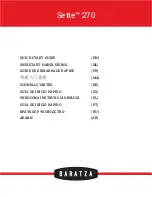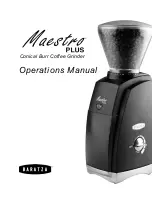
GB
- 31 -
speed of the angle grinder.
•
Use only grinding and cutting wheels that are
approved for a minimum speed of 11,000 rpm
and a peripheral speed of 80 m/sec.
•
Check the direction of rotation when you use
diamond cutting wheels. The directional arrow
on the diamond cutting wheel must point in
the direction in which the tool rotates.
Take special care that the grinding/sanding
wheels are properly stored and transported.
Ensure that the grinding/sanding wheels are
never exposed to shock, jolts or sharp edges (for
example during transport or storage in a toolbox).
This could cause damage (such as cracks) to the
grinding/sanding wheels and place the user in
serious danger.
6.6 Operating Modes
6.6.1 Rough grinding (Fig. 11)
For the best rough grinding results, hold the grin-
ding wheel at an angle of between 30° and 40° to
the workpiece surface and guide back and forth
over the workpiece in steady movements.
6.6.2 Cutting (Fig. 12)
When you use the right-angle grinder for cutting
purposes, avoid tilting it in the cutting plane. The
cutting wheel must have a clean cutting edge.
A diamond cutting wheel is best used to cut hard
stone.
It is prohibited to use the machine on as-
bestos materials!
Never use a cutting wheel for rough grin-
ding.
7. Replacing the power cable
If the power cable for this equipment is damaged,
it must be replaced by the manufacturer or its
after-sales service or similarly trained personnel
to avoid danger.
8. Cleaning and maintenance
Always pull out the mains power plug before star-
ting any cleaning work.
8.1 Cleaning
•
Keep all safety devices, air vents and the
motor housing free of dirt and dust as far as
possible. Wipe the equipment with a clean
cloth or blow it with compressed air at low
pressure.
•
We recommend that you clean the device
immediately each time you have finished
using it.
•
Clean the equipment regularly with a moist
cloth and some soft soap. Do not use
cleaning agents or solvents; these could at-
tack the plastic parts of the equipment. Ensu-
re that no water can seep into the device. The
ingress of water into an electric tool increases
the risk of an electric shock.
8.2 Carbon brushes
In case of excessive sparking, have the carbon
brushes checked only by a quali
fi
ed electrician.
Important! The carbon brushes should not be rep
laced by anyone but a quali
fi
ed electrician.
8.3 Maintenance
There are no parts inside the equipment which
require additional maintenance.
9. Disposal and recycling
The equipment is supplied in packaging to pre-
vent it from being damaged in transit. The raw
materials in this packaging can be reused or
recycled. The equipment and its accessories are
made of various types of material, such as metal
and plastic. Never place defective equipment in
your household refuse. The equipment should
be taken to a suitable collection center for proper
disposal. If you do not know the whereabouts of
such a collection point, you should ask in your
local council o
ffi
ces.
10. Storage
Store the equipment and accessories out of
children’s reach in a dark and dry place at above
freezing temperature. The ideal storage tempe-
rature is between 5 and 30 °C. Store the electric
tool in its original packaging.
Anl_TE_AG_115_750_DP_SPK8.indb 31
Anl_TE_AG_115_750_DP_SPK8.indb 31
08.04.13 08:41
08.04.13 08:41














































